The extreme increase in wholesale gas prices is developing into a serious cost problem for manufacturers of energy-intensive basic chemicals. The impact on nitrogen products is already clear to see. Read this article to find out why this is so, which products are particularly hard hit and what the supply situation is like.
Why the gas price has risen so much
In recent months, wholesale prices for gas have risen to record levels worldwide. Procurement prices for natural gas on the futures market have increased by more than 400 per cent within a year. Whereas in August 2020 an average of 4.80 euros was still being paid for a megawatt hour on the wholesale market, this costs around 44 euros on the current futures market. For short-term procurement, the prices go up to 75 euros in some cases.
Experts assume that the high gas price level in wholesale will continue for some time. A stronger price decline is not expected until spring 2022. The causes for these capers on the energy market are rooted in both supply and demand:
- Rising global demand: High demand in the wake of the global economic recovery is currently meeting with reduced supply. A high proportion of liquefied natural gas (LNG) is also being supplied to the Asian market and to North and South America, but less to Europe compared to recent years. The reason for this is the reduced energy production of hydropower plants in these countries due to the heat wave as well as better prices for gas suppliers than in Europe.
- High gas consumption: Cold winters in many regions as well as below-average wind power feed-in for several months caused gas storage inventories in Europe to drop. As a result, conventional power plants have to produce more electricity - and this, too, partly with gas.
- Relatively low stock levels: Normally, gas storage facilities are replenished in the summer at favourable prices. This year, for various reasons, this did not happen. Because of the high gas prices, gas storage facilities in the EU are now only 70 percent full on average. According to E-Control, the fill levels of the storage facilities relevant for Austria are currently between 66 and 87 percent, i.e. at a reasonably normal level.
- Reduced gas production in Europe: The gradual shutdown of the Groningen field in the Netherlands and the declining supply from Great Britain are leading to a substantially reduced volume of natural gas in Europe. In addition, there are various maintenance activities in European gas-producing countries such as Norway.
- EU energy policy: The pending operating permit for the completed NordStream 2 Baltic Sea pipeline could have an additional effect on prices. Basically, the dispute between the EU and Russia is about whether or not the European Gas Directive, which will be amended in 2019, will be applied. The directive stipulates that gas pipelines between the EU and third countries must comply with European regulation.
The extreme increase in wholesale gas prices is developing into a serious cost problem for manufacturers of energy-intensive basic chemicals. The impact on nitrogen products is already clear to see. Read this article to find out why this is so, which products are particularly hard hit and what the supply situation is like.
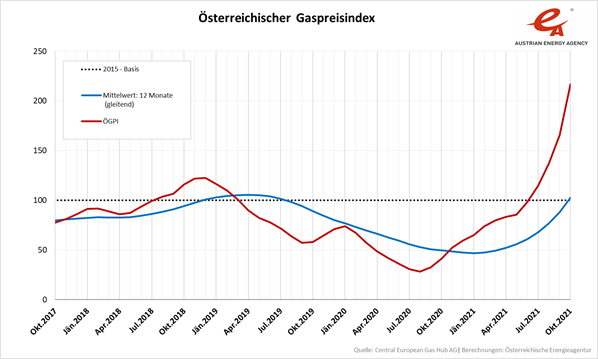
The Austrian Gas Price Index (ÖGPI) increases by 30.9 % in October 2021 compared to the previous month of September. Compared to October 2020, it is 425.1 % higher. The index calculated by the Austrian Energy Agency rises to 217.01 points in October 2021. In the past twelve months, the ÖGPI averaged 102.64 points.
© Austrian Energy Agency
Gas price leads to price increase in the entire energy sector
The gas price explosion is having a wide impact, directly and indirectly affecting the entire energy sector. High price increases are particularly noticeable for electricity, but also for coal and oil:
- Electricity: In Europe, electricity is still very much generated by gas. The gas price increase on the wholesale markets thus has a 1:1 impact on the electricity price. While at the beginning of the fourth quarter of 2020 the price of electricity was 40 euros per megawatt hour, one year later the price is three times that at more than 120 euros.
- Oil: Since the prices for gas and coal have risen sharply in recent months, oil is increasingly coming into consideration as an alternative energy source. This is also driving up oil prices strongly. At present, a barrel of North Sea Brent costs as much as it did about three years ago. The US oil price is even at its highest level in seven years.
- Coal: Higher gas prices increase the demand for coal, for example in power generation.
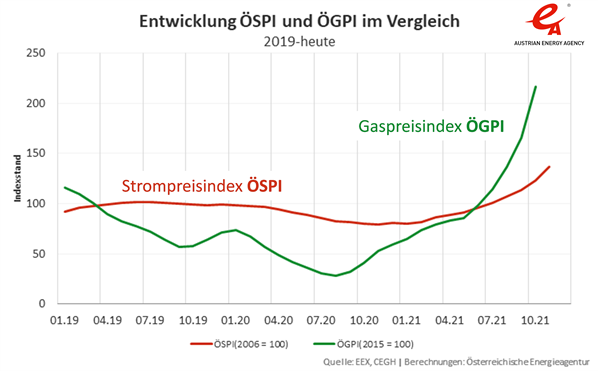
The extreme price increases in natural gas wholesale are now, with a delay, also causing significant increases in the price of electricity.
© Austrian Energy Agency
Serious cost problem for energy-intensive companies
In general, a large number of chemicals are currently experiencing sharp price increases due to higher energy costs. Basically, two groups can be distinguished here:
- The first group includes chemicals that are indirectly affected by rising energy costs due to the coupling of gas and electricity prices. These include electrolysis products such as sodium hydroxide solution and potassium hydroxide solution, the production of which is very electricity-intensive.
- The second group is directly dependent on natural gas in the manufacturing process.The production of nitrogen products is currently particularly affected by the gas price explosion.
Electrolysis products have seen price increases of between 20 and 25 per cent in the last quarter. This is quite dramatic for this product group. However, the price increases of nitrogen products are currently more critical.
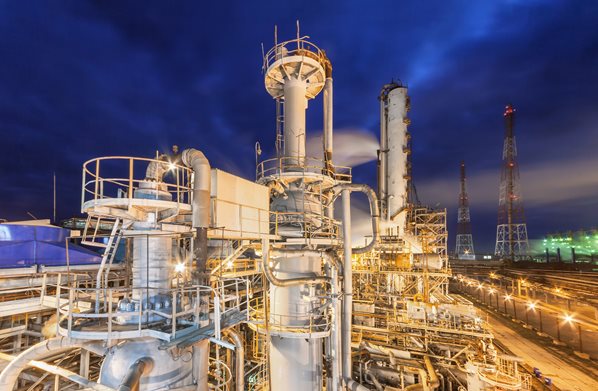
Production plant for the manufacture of ammonia and nitrogen fertilisers. © Всеволод Чуванов, stock.adobe.com
Nitrogen products dependent on gas
The price of nitrogen products depends primarily on the energy costs for operating the production plants. Natural gas plays a central role here. The raw material itself, namely air, is not important in terms of cost.
The technically most important nitrogen compound is ammonia. The chemical is produced directly from the air and serves as the basic material for all other nitrogen compounds:
- The starting materials for ammonia synthesis are obtained from the catalytic conversion of natural gas (methane) with water vapour and air.
- This process produces a gas mixture of hydrogen and nitrogen, which is further processed into ammonia using the Haber-Bosch process.
The high energy requirement for the production of the pure hydrogen needed in the Haber-Bosch process is ultimately also the reason for the enormous price increase for nitrogen products: If the costs for natural gas rise, then the prices for ammonia and the nitrogen products produced from it rise to the same extent.
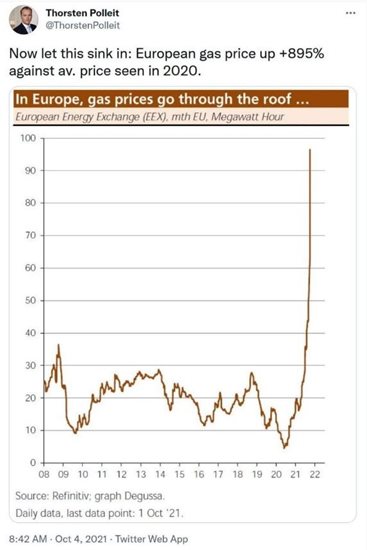
Fertiliser industry under massive pressure
The main use of ammonia comprises 80 per cent of the production of agricultural fertilisers. Ammonia can be applied alone as fertiliser, but is mostly converted into other nitrogen products such as urea or nitrates. The remaining 20 per cent is used, among other things, for the production of various organic intermediates as well as plastics and synthetic fibres.
The level of natural gas prices that has now been reached makes it more difficult for fertiliser producers to cover their costs. The Austrian fertiliser producer Borealis AG has already pulled the emergency brake and cut its ammonia production in Europe. Some other large producers are now also cutting back on fertiliser production.
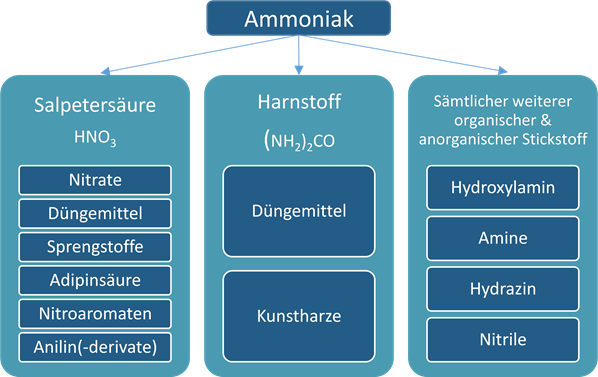
Ammonia is one of the most important basic chemicals and serves as a starting material for numerous chemical syntheses. © Donauchem
Prices high, supply situation currently stable
In October alone, prices for nitrogen products rose by up to 170 percent within ten days as a result of the gas crisis. However, according to Donauchem suppliers, there is currently no immediate threat to the supply of nitrogen products. There is also no information that there will be shutdowns of production plants throughout the industry because of the energy prices.

Price range for wholesale nitrogen products (depending on manufacturer) © Donauchem
Conclusion: What Donauchem does for your supply security
Donauchem observes current developments very closely and intervenes in a supportive and regulatory manner within the scope of feasible options. In cooperation with customers and suppliers, we focus above all on stabilising the price structure as far as possible. The security of supply for nitrogen products is currently given, albeit with considerable price surcharges. Of course, we remain true to our quality standards despite the tense price situation - you will continue to find only high-quality products in our portfolio.
 www.donauchem.at
Weiterführende Links:
News to go - Gaspreis auf Rekordniveau
Tagesschau.de
www.donauchem.at
Weiterführende Links:
News to go - Gaspreis auf Rekordniveau
Tagesschau.de - Wie der hohe Gaspreis entsteht
Tagesschau.de - Teurer Dünger belastet Landwirte
Focus.de - Dünger so teuer wie seit 13 Jahren nicht mehr
orf.at - Wie mann Stickstoffdünger einsparen könnte